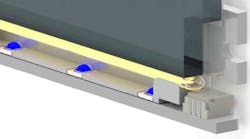Interview: QD Vision's Carlson And Coe-Sullivan Discuss Why Color Matters
Picture quality is a key component of any display device, and pressure to improve color performance and accuracy, particularly in large format displays, is driving display manufacturers to continuously innovate. In order to protect profit and remain competitive in the very crowded consumer space, it is imperative that television manufacturers and panel designers close the color performance gap completely, and do so at the lowest possible cost of technology and integration.
I recently had an opportunity to speak with Dr. Seth Coe-Sullivan and Jason Carlson of QD Vision about their company and technology. QD Vision is a leading nanomaterials product company delivering commercially viable quantum dot optical components that provide full-gamut color and cost savings for advanced display solutions.
Wong: Tell me a little bit about QD Vision?
QD Vision: QD Vision, Inc. was founded in 2005 by Dr. Seth Coe-Sullivan and Dr. Jonathan Steckel to advance the work of QD Vision’s co-founders and scientific advisors, including MIT professors Vladimir Bulovic and Moungi Bawendi (considered by many to be the father of quantum dot technology). Leveraging this rich set of intellectual assets, we developed QD Vision and our proprietary Color IQ technology (Fig. 1). Today, the company operates the world’s largest quantum dot production facility and has the distinction, with the 2013 introduction of ten production model Sony Bravia TVs, of being the first to market with a commercially viable quantum dot technology solution in displays. Today, we hold over 50 patents in quantum dot materials, methods, and applications, with more than 200 patents pending.
Related Articles
- Thick-Shell Quantum Dot Technology Increases Display Performance
- Nanocrystal Quantum Dots Efficiently Emit Laser Light
- QLEDs: Another Contender In Next-Generation Lighting
Wong: Tell me about quantum dots and Color IQ?
This file type includes high resolution graphics and schematics when applicable.
QD Vision: Quantum dots are a semiconductor nanocrystal technology that precisely and efficiently emit light to provide full-gamut color performance and accuracy in LCD displays. Color IQOptics, our brand of optical components, enable LCD TVs to produce very saturated and narrow bands of color at any wavelength. While most LCD TVs and displays today offer color quality with a partial color gamut often ranging from 60-70 percent of the NTSC standard, products using Color IQ optical components can achieve 100 percent of the standard and beyond without compromising accuracy. The result provides the most radiant reds, brilliant blues and gorgeous greens you will ever see.
Wong: How will quantum dots and Color IQ influence LCD displays?
QD Vision: We believe that by improving LCD technology, Color IQ optics will help to extend LCD TVs’ lifetime in the market. Full-gamut color refers to the ability of an LCD device to display the widest range of colors available with 100 percent overlap of a color space as defined by the content creation community. Quantum dot-based solutions are not limited to the current gamut specifications and, in fact, can support color gamut well beyond what is available today. Because quantum dot materials are inherently efficient light emitters, they don’t require the cost/performance trade-offs typical of other materials and lighting technologies. These are just some of the reasons we believe that the adoption of quantum dot technology, Color IQ optics and full-gamut color, is inevitable for LCD displays.
Wong: How does color affect image quality and viewer perception?
QD Vision: Research links the perception of quality with highly saturated colors, enabled by expanded color-gamut, to both viewer attention (dwell time) and preference.
There is both a psychology and biology associated with color’s role in the perception of picture quality. Humans are trichromatic, meaning we are tuned to distinguish a wide variety of wavelengths and hues of blue, green and red. In the last 10 years, rigorous research has demonstrated that colorfulness is the main perceptual attribute underlying image quality.
For viewers, color accuracy is closely related to the perceived “naturalness” of an image, based on memory color and skin tone. Researchers have found that while the perception of quality rises with color saturation, it is only true up to the point at which skin tone starts to appear “unnatural.”
Wong: I’ve heard that increased color-gamut infers a tradeoff with color accuracy. Is this true?
QD Vision: Not at all. In fact, full-gamut color is necessary to achieve both dimensions of viewer preference: colorfulness and color accuracy.
Video content creators define accuracy by agreeing on various color space dimensions within the total area of perceivable color. Thus accuracy is the correct display of colors exactly as intended within a standard color-gamut. TV industry consultants and technicians calibrate and measure the degree to which a consumer device accurately displays colors within the area of a particular color-gamut standard. Examples include NTSC, Rec. 709, Adobe RGB, and DCI. These standards are important in that they give TV designers a metric of compliance to content creator choices.
The relationship between full color gamut and accuracy is an important distinction for quantum dot based solutions. With Color IQ optics, the accuracy is not compromised as gamut is expanded.
Wong: Recent single-digit TV set market growth reports have put enormous pressure on LCD panel makers to reduce costs, so why would they invest in color-gamut expansion now?
QD Vision: In order to protect profit, it is imperative that panel designers close the color performance gap completely. The most compelling argument for immediate implementation of full-gamut color is the now established commercial viability of quantum dot optical products. Quantum dots enable OLED-quality color at product costs well within the range of LCD TV retail pricing targets. Quantum dot optical products ship in volume today, delivering well received full-gamut color in both television and tablet LCD displays.
Wong: How do you see the full-gamut LCD display market shaping up?
QD Vision: As with the transition from standard definition to HD, there are short-term gaps to address in content distribution standards, content availability, and the software layer to better support the new optical components’ capabilities, but these challenges are readily addressable by several large-ecosystem communities that are incented to tackle them.
Content creation and processing equipment makers, as well as display suppliers, are anxious to offer consumers the next level of performance, bringing a cinema-quality viewing experience to mainstream, affordable home theaters. All of the ingredients are available to make full-gamut color display a reality, and like prior display technology transitions, including the transition to LEDs themselves, better consumer value will drive surprisingly rapid penetration. This is why QD Vision believes that full-gamut LCD TVs with quantum dot optics will achieve significant market penetration in 2014.





